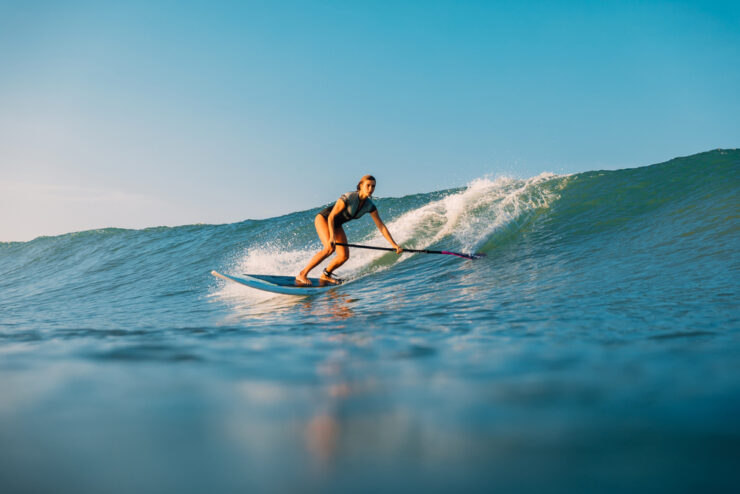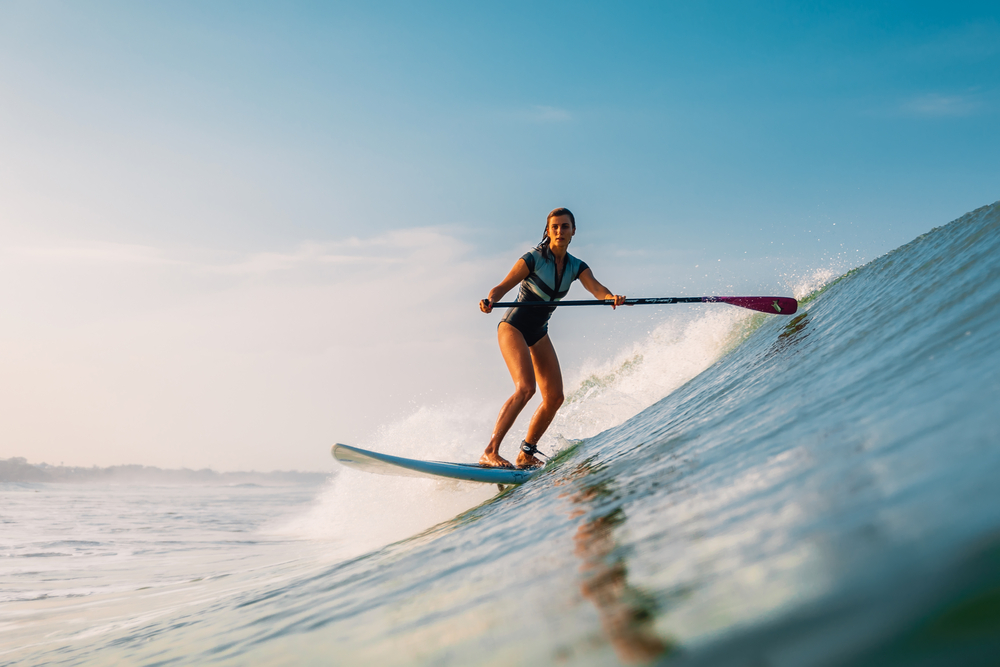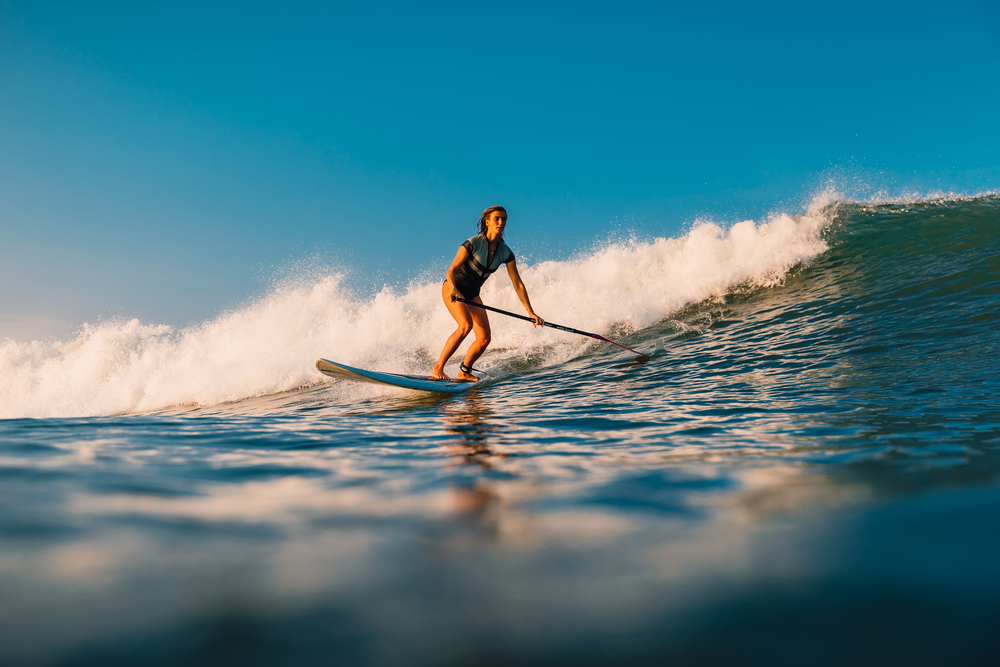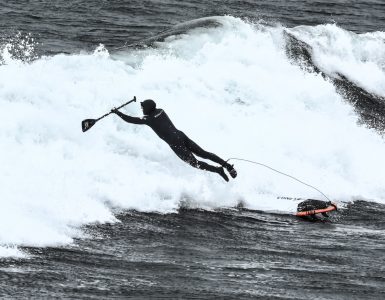Many people are familiar with stand-up paddling, but did you know that the boards are also used to ride waves? SUP surfing is the name of the game, and SUP boards can now be found at many surf spots.
Find the right surf SUP board:
In our Checklist, we show you at a glance what to look out for in wave SUP boards. In the guide, we also explain in detail how the boards are constructed and which boards are suitable for what. To make it easier to choose the right model, we present the best SUP surfboards 2024 in our recommendations.
Contents:
- Top picks: The best surf SUP boards 2024 reviewed.
- Checklist: These features are important in the test.
- Bestseller: Overview of the most popular surf SUP boards.
- Guide: You should pay attention to this before buying.
- FAQ: Frequently asked questions and answers about surf SUP boards.
The best surf SUP boards 2024 reviewed
1. best surf SUP board with dry bag for paddle board
This board measures 320 x 78 x 15 cm and weighs around 15 kilograms. The set includes a leash, pump, adjustable paddle, carrying backpack, repair kit, carrying strap, waterproof bag for valuables and a detachable fin.
- Driving characteristics
- Customer service
- Lots of accessories
- Kayak seat not included
Why we like it: The high-quality model is very robust thanks to the drop-stitch material and can also reach higher speeds thanks to its design. Thanks to its thickness, the board is particularly stable and offers good buoyancy. A kayak seat can be attached to the existing D-rings.
Recommended for: The Aquaplanet SUP board is designed for a paddler weight of up to 120 kilograms and can carry a total weight of 152 kilograms. It is suitable for both beginners and advanced users.
2. best stable surf SUP board
This Sup has dimensions of 320 x 81 x 15 cm and weighs around 9 kilograms. The set contains everything you need to start riding straight away. From paddle to transport backpack, pump, leash center fin, to a repair kit in case the board has a hole.
- Stability
- Fast assembly
- Customer service
- Backpack not particularly robust
Why we like it: The SUP board from Goosehill is very stable and offers a lot of safety on the water, especially for beginners. It is available in 12 different designs, so there is something for every taste. It is lightweight and therefore easy to transport and carry to the water. The weight also helps to achieve a good speed with little effort.
Recommended for: The board can bear loads of up to 150 kilograms and can therefore also be used by 2 people. It is suitable for beginners and advanced users.
3. best surf SUP board with bag
This board has dimensions of 315 x 83.8 cm, a volume of 284 liters and a weight of 8.3 kilograms. The high-quality, lightweight carbon paddle supplied facilitates propulsion and steering. An integrated cover net provides fastening options for luggage.
- Quality
- Easy inflation
- Price
Why we like it: Fanatic is a renowned SUP manufacturer that impresses with its particularly high-quality workmanship. The Fanatic Fly Air is easy to transport with the large and sturdy bag, while the padded carrying straps ensure a high level of comfort. The center fin can be removed without tools and a carrying handle makes it easier to transport the board into the water.
Recommended for: The board is ideal for paddlers with a body weight of up to 95 kilograms.
4. best inflatable surf SUP board
The board is supplied with a pump, transport bag with wheels, luggage net and a leash that can be attached to a D-ring. The fin system works without tools and can be attached and removed quickly. Strength and stability are guaranteed by the drop-stitch material.
- Stabilität
- Einfaches Anbringen der Finnen
- Für Anfänger geeignet
- Ohne Paddel
- Preis
Warum wir es mögen: Bei dem Starboard iGo Deluxe handelt es sich um ein besonders steifes und belastbares SUP Board. Mit der mitgelieferten Doppelhub-Pumpe lässt es sich schnell aufpumpen und kann mit dem Schultergurt ohne große Mühe getragen werden.
Empfohlen für: Das Board eignet sich gut für Familien und kann auch von Einsteigern gut gefahren werden.
5. Bestes preiswertes Surf SUP Board
When inflated, this board measures 335 x 84 x 15 cm and weighs just under 15 kilograms. It is supplied with an electric pump including attachments that can be plugged into the car's cigarette lighter. Also included are a paddle, repair kit, leash, carrying strap, fin and transport backpack.
- Preis
- Verarbeitung
- Viel Zubehör
- Aufpumpen mit mitgelieferter Pumpe dauert recht lange
Warum wir es mögen: Mit dem niedrigen Preis gehört das Board zu den günstigsten Modellen auf dem Markt. Es ist sehr kippstabil und wird mit einem umfangreichen Set an Zubehör geliefert. Das SUP ist in verschiedenen Ausführungen und Designs verfügbar und bietet das passende Modell für jeden Geschmack.
Empfohlen für: Das Board ist sowohl für Anfänger als auch für Fortgeschrittene eine gute Wahl. Es kann bis 160 Kilogramm belastet werden.
6. Bestes Surf SUP Board-Set
The board measures 320 x 83 x 15 cm and has a volume of 300 liters. The 150 mm thick Drop Stitch core makes the SUP particularly firm and stable without affecting the riding characteristics.
- Suitable for beginners
- Customer service
- Robust
- Assembly with supplied pump strenuous
Why we like it: For a board that comes in a complete set, the F2 Strato is very reasonably priced. The scope of delivery includes a pump, leash, fin, repair kit, paddle and bag. It weighs just 7.65 kg and can also be easily transported by children.
Recommended for: The board can carry loads of up to 130 kilograms. It can be accelerated quickly and turned easily.
7. best high quality surf SUP board
This SUP measures 325 x 81 x 15 cm, has a volume of 295 liters and weighs just over 10 kilograms. It is supplied with a transport rucksack, leash, fin, paddle, pump and kayak seat.
- Processing
- Lots of accessories
- Stability
- Bag too small to store all the accessories
Why we like it: The design of the board allows it to accelerate quickly and turn well, while the drop stitch core provides stability. The backpack supplied has wheels to make transportation easier. The air pump has a pressure gauge that indicates whether there is enough air in the board.
Recommended for: The SUP board from Brunelli is the ideal companion for your next family outing. With its large footprint, it offers space for an adult with children and has enough buoyancy to transport a weight of up to 180 kg over the water.
Even more interesting recommendations and guides:
- Inflatable paddle boards
- All-round SUP boards
- Hardboard SUP
- Race SUP Boards
- Surf SUP Boards
- SUP board with dog
- Touring SUP Boards
- Yoga SUP Boards
- WindSUP Boards
- SUP Board comparison
Surf SUP Board Checklist: These features are important in the test
- Length: The length of the wave SUP board has a direct effect on the riding characteristics. Long boards are more stable, but less maneuverable. With short surf SUP boards, it’s the other way around. Long SUP boards are also better suited for flat water paddling.
- Width: The width of the surf SUP board is just as important. While narrow boards are best suited for radical maneuvers and tight turns, wide boards are more stable, less manoeuvrable and therefore the right choice for surf paddle boards for beginners.
- Thickness: The thickness of the board is measured at the widest point, the thickness varies along the board. The SUP board is thickest at the height of the standing surface, as this is where most of the weight is on the board.
- Volume: Length, width and thickness have a direct effect on the volume of the surf SUP board. A board with a lot of volume is best suited for beginners. With such boards it is easy to paddle into waves and they are very stable.
- Shape: There are countless different shapes for SUP surfboards. When we talk about the shape, we mean the following parts of the surf SUP board:
- Nose: This is what the tip of the board is called. It can have either a round or pointed shape. A round nose makes it easier to paddle into waves, and a round tip also gives the board more stability. Paddle boards for beginners in particular should therefore choose a surf SUP board with a round nose.
- Tail: The tail is located at the rear end of the wave SUP board. The shape of the tail affects the stability, grip in the wave and maneuverability of the board. The most common shapes are Square Tail, Round Tail and Swallow Tail.
- Rocker: This refers to the bend of the SUP board from the tail to the nose. The board can either have a strong rocker (strongly curved upwards) or a flat rocker (less curved, rather flat). A flat rocker is well suited for beginners, but is not the best choice for choppy water. A strong rocker is ideal for SUP surfing, as it makes radical maneuvers and tight turns possible.
- Rails: The rails are the outer edges of the surf SUP board, and a distinction is made between soft and hard rails. The rails can also be thick or thin, which affects the board volume.
- iSUP vs. hard SUP: Or portability vs. performance. Hardboards deliver significantly better performance, but take up a lot of space during storage and transportation. Inflatable paddle boards have poorer performance characteristics, but they are easy to roll up when deflated and can be transported in a backpack.
- Art:
- SUP shortboard: Shortboards are similar to the narrow and tapered surf shortboards, but are significantly larger and have a volume of < 150 L. Such boards are practically only suitable for SUP surfing, paddling in flat water is not much fun with a SUP shortboard.
- SUP longboard: Longboards are easy to recognize, they are between 9′ (approx. 275 cm) and 12’6” (381 cm) long. SUP longboards measure around 30” (approx. 76 cm) in width, so they are similar to classic all-round paddle boards and are also well suited for flat water paddling. Beginners can make their first SUP attempts in small waves. In big swells, however, such boards are reserved for advanced riders.
- SUP Fish: Here too, the shape is based on that of “normal” surfboards. SUP fish boards are wide and relatively short, making them ideal for small waves with little power.
- Surface: The surface of the SUP board must be fitted with a non-slip deck pad. This ensures a secure footing. A kickpad is also recommended for better control during turns. A luggage net is out of place here.
- Accessories: SUP equipment also includes: paddle board leash, wetsuit, fins.
Also interesting: The most popular inflatable SUP boards 2024.
Bestsellers: The most popular surf SUP boards on Amazon
(**Last update 2024-11-21)
Buy a surf SUP board:
How to make the right decision
Many factors play a role when buying a surf SUP board. The most important properties and features of surf SUPs include
Surf SUP types
The types of hard SUP boards are based on the shape of different surfboard types:
1 SUP Shortboards
- Similar to Surf Shortboards
- 7-9 feet (2.13 – 2.74 m) length
- Volume: 150 l
- Only suitable for SUP surfing
These boards look like the large version of surf shortboards and are between 7′ (approx. 2.13 m) and 9′ (approx. 2.74 m) long. The volume is less than 150 liters and the boards usually have a strong rocker and a pointed nose.
Who are SUP shortboards suitable for?
For advanced SUP surfers! Grabbing a shortboard too early is a mistake that many SUP surfers make when learning to surf. Instead, it is advisable to slowly work your way up from large to small boards.
Most SUP shortboards are unsuitable for paddling in shallow water.
2 SUP longboards
- Length: 9′-12’6” (approx. 274-381 cm)
- Width: around 30” (approx. 76 cm)
- Similar all round paddle boards
- There are also narrow models for advanced users
- Also suitable for shallow water
It’s best for paddle boards for beginners to choose a SUP longboard first, unless they already have a lot of surfing experience. Longboards are easy to recognize, they are between 9′ (approx. 2.74 m) and 12’6” (approx. 3.81 m) long and around 30” (76 cm) wide. This makes them similar to the shape of all round paddle boards.
Such models are not only suitable for SUP surfing in small waves, but also for paddling in flat water. Ideal for anyone who wants to do more than just surf with their SUP board.
For advanced riders, there are also narrow longboards that are better suited to medium to large waves.
3 SUP Fish
- Wide and short
- Good for waves with little power
- Fish Tail
Compared to other SUP boards, the Fish is very wide and short, making it easy to surf small waves with little power. The fish is characterized by its swallow tail.
Length
The length of the surf SUP board has a significant effect on its riding characteristics.
As a general rule, long boards are stable and less maneuverable, while short boards are less stable and more maneuverable.
Can I also ride the surf SUP board in shallow water?
It all depends on the length of the board, because length matters. If you also want to paddle on the lake, you should buy a surf SUP board with a length of at least 9-10 feet (2.74 – 3.04 m). Short boards do not go straight well and are more strenuous to paddle.
Width
The width also plays an important role for surf SUP boards and has a direct effect on their riding characteristics. Beginners choose a long board. If you improve over time, you can surf smaller and smaller boards.
- Wide surf SUP boards: The wider the board, the more stable it is, but the less maneuverable it is.
- Narrow surf SUP boards: A narrow SUP surfboard is suitable for radical maneuvers and tight turns.
Thickness
The thickness of the SUP board is measured at the thickest point, as the board is not equally thick at every point. The surf SUP board is usually thickest under the standing surface, as this is where the most weight is applied to the board.
Stability or maneuverability?
The thickness of the board affects its stability and maneuverability. The thicker the board, the more stable and less maneuverable it is and vice versa.
Volume
The volume of the board is directly related to the length, width and volume. How much volume a surf SUP board needs to have depends on the paddler’s body weight.
As a rule of thumb:
- Volume for beginners = body weight in kg x 2
- Volume for advanced users = body weight in kg x 1.7
- Volume for professionals = body weight in kg x 1.3
The more volume a surf SUP board has, the more stable it is in the water and the easier it is to catch waves. Boards with less volume are less stable, but experienced SUP surfers compensate for this with their skills.
This is because boards with less volume are very maneuverable and ideal for a radical riding style. This is why such boards are preferred by many advanced and professional riders.
What many beginners don’t know:
A small board may seem practical and attractive at first. However, it should be noted that such boards are only suitable for SUP surfing. If you buy a board that is too small too soon, you won’t be able to get to grips with it well – it takes some practice first.
Shape
The shape describes the shape of the surfboard and is primarily dependent on the following parts of the SUP surfboard:
- Nose
- Tail
- Rocker
- Rails
It is not a single element that determines the riding behavior of the board, rather the individual parts form a large whole and must therefore be well coordinated.
1. Nose:
The tip of the SUP board is called the nose. The nose can have a round or pointed shape and has an effect on the surf SUP board’s handling.
- Wide nose: Makes it easier to get waves, provides stability and is best suited for beginners.
- Pointed nose: A pointed nose is particularly suitable for steep waves and makes the SUP board easier to turn.
2. tail:
The tail is located at the rear end of the wave SUP board, the shape of which has an effect on grip in the wave and maneuverability. Incidentally, more volume at the tail provides more stability, less volume improves performance and turning ability.
The following three tail shapes are the most common:
- Square Tail: Maneuverable, wide and therefore gives a good grip in the wave, but Round Tail is better suited for beginners.
- Round Tail: The best choice for beginners Although boards with a round tail are not speed machines, the tail makes it easier to catch waves and provides a good grip.
- Swallow Tail: The Swallow Tail is reminiscent of a swallow tail and makes the board agile and fast.
3. rocker:
The rocker describes the bend of the surf SUP board from the tail to the nose. This is referred to as either a flat rocker (not bent upwards or slightly bent upwards) or a strong rocker (strongly bent upwards).
Continuous or discontinuous rocker?
If the rocker extends over the entire board, this is called continuous rocker. If parts of the board are curved and other parts are flat, this is referred to as discontinuous rocker. Depending on how the rocker is distributed, the riding characteristics of the board also change.
Flat rocker:
- Little water resistance
- Good for riding in shallow water
- Surfing in small waves
- Shaky with cable water
Surf SUP boards with a flat rocker line have less water resistance as the board has an even contact surface. If you only surf in small waves and want to paddle with your SUP board, choose a board with a flat rocker.
However, boards with flat rocker are not the best choice for choppy water. This slows the board down and makes it less stable in the water.
Strong rocker:
- Radical driving style
- For steep waves
- Not suitable for riding in shallow water
If you want to ride big waves and perform radical turns, you need a SUP board with a strong rocker paddle board. This makes the board more maneuverable and allows you to make tight turns.
As a smaller part of the board rests on the water, surf SUP boards with a strong rocker are unsuitable for normal paddling.
4. rails:
The outer edge of the board is called the rail, and a distinction is made between hard and soft rails. The shape affects the board’s handling and directs the water flow along the edges.
Soft rails:
Have a rounded shape. Here the water flows unhindered past the edge. Boards with a soft rail have more volume, are less maneuverable and slower due to the increased water resistance. Nevertheless, boards with a soft rail are the best choice for beginners.
Hard rails:
Here, the rail does not merge roundly into the underside, but has a clear edge. This directs the water away from the rail, making the board much more maneuverable.
iSUP vs. hard SUP
This raises the question of what demands are placed on the surf SUP board. Is the focus more on performance or portability? Advantages and disadvantages of inflatable and hard wave SUP boards
Inflatable paddle board:
- Easy transportation and storage
- Ideal for traveling
- For small waves and shallow water
- Robust
- Poorer performance
- No real shape
- Less stiff
- Must be inflated
Inflatable paddle boards are incredibly popular, but they are not the best choice for SUP surfing. Although the boards are easy to transport and store, they perform worse on the waves than hard SUP boards.
Surfing and paddling:
Nevertheless, inflatable surf SUP boards can be a good choice, especially when paddling in flat water and only surfing small waves. The boards are also very robust and blunt objects often leave hardly any damage.
Why do inflatable boards perform worse?
The boards are significantly less rigid, bend under high loads and are therefore less able to withstand the force of the wave. Wave iSUPs can also be shaped less precisely. Thin rails and a strong rocker are practically impossible here.
Hard SUP boards:
- Best performance
- Can be shaped precisely
- Stiffness
- Takes up a lot of space
- Susceptible to damage
- Price
If you really value performance, we recommend a hard surf SUP board. The firm boards provide the best riding feel, while the stiffness and light flex ensure that the board responds perfectly to movement.
In contrast to inflatable paddle boards, the shape offers unlimited possibilities. Here, everyone can find a board that suits their personal requirements.
The disadvantage of hard SUP boards:
The large boards take up a lot of space during storage and transportation, which means there must be enough storage space and a car available. Most hard SUP boards consist of a foam core covered with fiberglass or carbon and are susceptible to so-called dings.
In addition, hard SUP boards are significantly more expensive than inflatable boards.
Surface and accessories
The surface of surf SUP boards is usually equipped with a non-slip deck pad to prevent you from slipping while surfing. If this is not the case, the board must be waxed.
A kickpad at the tail helps with orientation on the board and makes turns easier. By the way, a luggage net has no place on a surf SUP board!
The following accessories are also available for surf SUP boards:
- SUP pump
- SUP paddle
- SUP Leash
- SUP fins
- SUP seat
- SUP backpack
- SUP motor
- SUP bag
- SUP transport trolley
- SUP shoes
- Paddle board life jacket
- SUP dry suit
How does SUP surfing work?
In this video, Waterman Kai Lenny shows what a really good SUP surf session looks like:
You are currently seeing a placeholder content of YouTube. To access the actual content, click on the button below. Please note that data will be passed on to third-party providers.
FAQ: Frequently asked questions and answers about surf SUP boards
What is a surf SUP board?
Which is the best surf SUP board?
Which SUP for the sea?
What is the best length for a surf SUP?
Are there also big wave SUP boards?
Is the Kesser Wave SUP a good choice for SUP surfing?
Where can I buy a surf SUP board?
How expensive is a good surf SUP board?
What to look out for when buying used SUP boards?
What alternatives are there to surf SUP boards?
Is there a test from Consumer Reports or Öko Test on surf SUP boards?
*Price includes VAT, plus shipping. Customer reviews, prices, delivery times and costs may change in the meantime. By linking to selected online shops and partners, we may receive a small affiliate commission. There are no additional costs for you.




















Add comment